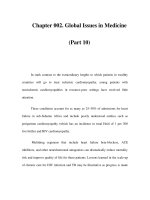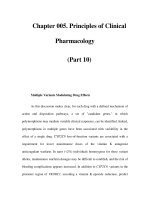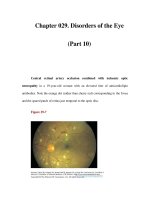Chapter 055. Immunologically Mediated Skin Diseases (Part 10) pot
Bạn đang xem bản rút gọn của tài liệu. Xem và tải ngay bản đầy đủ của tài liệu tại đây (12.74 KB, 5 trang )
Chapter 055. Immunologically
Mediated Skin Diseases
(Part 10)
Scleroderma often eventuates in development of an expressionless, mask-
like facies.
Morphea is characterized by localized thickening and sclerosis of skin,
usually affecting young adults or children. Morphea begins as erythematous or
flesh-colored plaques that become sclerotic, develop central hypopigmentation,
and demonstrate an erythematous border. In most cases, patients have one or a few
lesions, and the disease is termed localized morphea. In some patients, widespread
cutaneous lesions may occur, without systemic involvement. This form is called
generalized morphea. Most patients with morphea do not have autoantibodies.
Skin biopsy of morphea is indistinguishable from that of scleroderma. Linear
scleroderma is a limited form of disease that presents in a linear, bandlike
distribution and tends to involve deep as well as superficial layers of skin.
Scleroderma and morphea are usually quite resistant to therapy. For this reason,
physical therapy to prevent joint contractures and to maintain function is
employed and is often helpful.
Diffuse fasciitis with eosinophilia is a clinical entity that can sometimes be
confused with scleroderma. There is usually the sudden onset of swelling,
induration, and erythema of the extremities frequently following significant
physical exertion. The proximal portions of extremities (arms, forearms, thighs,
legs) are more often involved than are the hands and feet. While the skin is
indurated, it is usually not bound down as in scleroderma; contractures may occur
early secondary to fascial involvement. The latter may also cause muscle groups to
be separated and veins to appear depressed. These skin findings are accompanied
by peripheral blood eosinophilia, increased erythrocyte sedimentation rate, and
sometimes hypergammaglobulinemia. Deep biopsy of affected areas of skin
reveals inflammation and thickening of the deep fascia overlying muscle. An
inflammatory infiltrate composed of eosinophils and mononuclear cells is usually
found. Patients with eosinophilic fasciitis appear to be at increased risk to develop
bone marrow failure or other hematologic abnormalities. While the ultimate
course of eosinophilic fasciitis is uncertain, many patients respond favorably to
treatment with prednisone in doses ranging from 40–60 mg/d.
The eosinophilia-myalgia syndrome, a disorder reported in epidemic
numbers in 1989 and linked to ingestion of L-tryptophan manufactured by a single
company in Japan, is a multisystem disorder characterized by debilitating
myalgias and absolute eosinophilia in association with varying combinations of
arthralgias, pulmonary symptoms, and peripheral edema. In a later phase (i.e., 3–6
months after initial symptoms), these patients often develop localized
sclerodermatous skin changes, weight loss, and/or neuropathy (Chap. 316). The
precise cause of this syndrome, which may resemble other sclerotic skin
conditions, is unknown. However, the implicated lots of L-tryptophan contained
the contaminant 1,1-ethylidene bis[tryptophan]. This contaminant may be
pathogenic or a marker for another substance that provokes the disorder.
Further Readings
Anhalt GJ: Paraneoplastic pemphigus. J Investig Dermatol Symp Proc 9:29,
2004 [PMID: 14870982]
Braverman IM: Connective tissue diseases, in
Skin Signs of Systemic
Disease, 3d ed. Philadelphia, Saunders, 1998
Mutasim DF et al: Immunobullous diseases. J Am Acad Dermatol 52:1029,
2005 [PMID: 15928622]
Payne AS et al: Desmosomes and disease: Pemphigus and bullous
impetigo. Curr Opin Cell Biol 16:536, 2004 [PMID: 15363804]
Schmidt E, Zillikens D: Autoimmune and inherited subepidermal blistering
diseases: Advances in the clinic and the laboratory. Adv Dermatol 16:113, 2000
[PMID: 11094626]
Sontheimer RD: Skin manifestatio
ns of systemic autoimmune connective
tissue disease: Diagnostics and therapeutics. Best Pract Res Clin Rheumatol
18:429, 2004 [PMID: 15158749]
Udey MC, Stanley JR: Pemphigus—
diseases of antidesmosomal
autoimmunity. JAMA 282:572, 1999 [PMID: 10450720]
Y
ancey KB, Egan CA: Pemphigoid: Clinical, histologic,
immunopathologic, and therapeutic considerations. JAMA 284:350, 2000 [PMID:
10891967]









